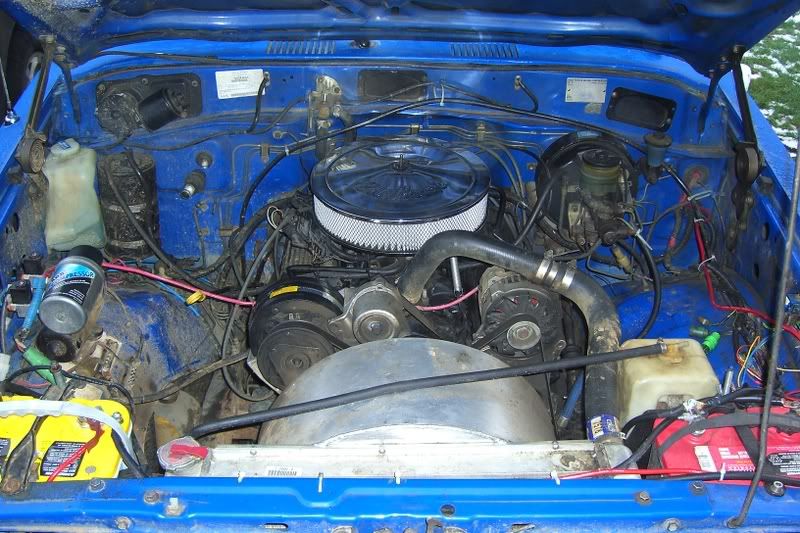Dual battery systems with these "isolators" sometimes cause problems because there is a voltage drop across the diodes inside them that can cause the alternator regulator to either marginally or greatly fail trying to properly charge the battery (not usually a “smoke test” problem but simply results in an improper charging of the battery). At best, the battery charging will be reduced somewhat due to this voltage drop and at worst the battery will not be charged at all. Isolators are typically used in motor homes and cause many headaches there as well. Some electrical experts and motor home engineers get around this problem by using special regulators to account for the extra diodes (and voltage drops across them) in the line. I have avoided isolators in the past and instead use my simple charging method outlined below.
A cheap way of keeping the auxiliary battery charged is by connecting a 10 gage wire from one battery (+) to the (+) of the other battery via a 40 AMP (or so) DC breaker (available sometimes from used electronic or aircraft surplus vendor - as long as the voltage of the breaker is rated DC and greater than 12 volts, then only worry about the AMP rating). With this setup you will need to mount the DC breaker in a place where it can be easily reset, as it will trip from time to time. It should be flipped on when the engine is running and off when it is not. (Should also be flipped and left on if a battery maintainer is used during vehicle storage, assuming of course that the two batteries are of the same chemistry, i.e. lead/acid and the same construction vented/not/jel/etc.).
Note: You can also insert an AMP meter inline with the DC breaker that connects the batteries. This AMP gage shows the amount of current flowing into the AUX battery (a positive value indicates auxiliary battery is taking on a charge from the engine battery/alternator). The accessories can be wired on the DC Breaker side of the AMP meter as well and the amount of current flowing out of the battery will register as well (negative value indicates drain).
With this setup, the breaker will trip from time to time. When and why? This simple circuit is designed only for charging and is not designed to electrically “high current” connect the batteries during times of severe drain where one battery might need more current from the other. Examples of this would be, i.e. when the engine is starting and severely draining the regular battery or when the wench is grinding out the last ounce of power from the AUX battery and starts pulling from the other. Now since there is no isolator, the batteries are in effect connected together and current will try to flow through the small wire (relative to the temporary very high current load). In this situation one battery begins to pull from the other through the charging circuit. Once that pull reaches a current level over 40 amps it will trip the “charging” breaker. No harm done; just reset it once the excessive load has passed and the engine is running and time to start charging again. (Circuit breaker left on all the time the motor is running under normal circumstances.) Note: Maybe some built this circuit without the DC breaker and wonder why it smoked one day when one battery went low??? Now you know.
When you need to do things like allow the wench to “siphon” from the motor’s battery/alternator or allow a dead motor battery to “siphon” off the AUX battery, then another economical solution would be to place your jumper cables between the two sets of batteries until the need is satisfied (or something runs down you didn’t necessarily want to run down ). Of course the expensive solution to this need is to use the heavy duty solenoids that come with some auxiliary battery kits or that can be purchased at an auto parts store. These heavy duty solenoids can be thought of as a remotely controlled person connecting jumper cables to the two batteries (as long as you hold in the button or switch on the dash, of course).
Footnotes …..
- if rule is followed to keep breaker on only when engine is running, then breaker will logically not trip when engine is started
- forgetting and leaving the breaker on when the engine is not running causes both stock accessories and new auxiliary accessories to drain from both batteries at the same time (switching the breaker off when engine if off prevents this problem)
- I used a 60 AMP DC ammeter which is the kind that has a 0 in the center, -60 amps to the left and +60 amps to the right. The plus sign on the back of the ammeter goes to the (+) terminal of the auxiliary battery, the (-) side of the ammeter goes to either side of the DC breaker (and optionally to any accessories that use less than 40A max), the other side of the DC breaker goes to the (+) of the engine battery
- The winch would connect directly to the (+) side of the AUX battery (would smoke the AMP meter if you wired it there)
Good luck!
-



